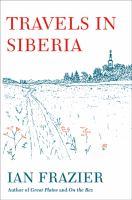
 I learned about Travels in Siberia from the New Yorker magazine which published short stories from Frazier’s Siberian trip. It enticed me to read the entire book about his adventures. This book is a unique chronicle through time about Siberia’s role in history. Frazier, with the help of two Russian guides and an unreliable car, undergoes incredible journeys and returns four times to learn about this land. Before him, many famous people traveled to Siberia in the 18th century, the great era of exploration. Frazier follows the tradition of these explorers.
I learned about Travels in Siberia from the New Yorker magazine which published short stories from Frazier’s Siberian trip. It enticed me to read the entire book about his adventures. This book is a unique chronicle through time about Siberia’s role in history. Frazier, with the help of two Russian guides and an unreliable car, undergoes incredible journeys and returns four times to learn about this land. Before him, many famous people traveled to Siberia in the 18th century, the great era of exploration. Frazier follows the tradition of these explorers.
The earliest mention of Siberia was in an Austrian map dated 1443. Marco Polo also reached Siberia on his travels. Frazier depicts Siberia’s great physical beauty, describes local people he encountered on this journey, and all the peculiarities observed by every foreign traveler in Russia. This can be incomprehensible to anyone who is not born or raised in Eastern Europe.
In between his trips while “Siberia sick” in New York City, where every possible ethnic group is represented, he tried to find something that would remind him of Siberia. The only place he found was a fur store with Russian sable coats.
Frazier writes that Siberia is an isolated region of undefined borders that covers one twelfth of the world’s land mass and spans over eight time zones. Archeologists believe that there are about fifty million animals buried in permafrost. They are not considered dinosaurs, but animals from an era 10-15,000 years ago.
Siberia is also a region of seismographic research and astronomical observations because there is no light pollution, and 300 days per year without clouds. The author tells us that there are only two Americans buried on Red Square. He visits new artificial cities that sprouted on the frozen tundra of Siberia. The tundra hides large deposits of minerals estimated to be the largest in the world.
In many cultures, Siberia is used as a metaphor for something restrictive and is associated with punishment and exile. It was once a penal colony of Russia hidden from the world. From the times of the Bolshevik revolution to the end of the Russian empire, an estimated 55-60 million people died of unnatural causes in corrective camps. Many great Russian minds, intellectuals and authors, found themselves exiled in Siberia. The author comments with astonishment that there are no memorials commemorating these places or the victims. The Russians have done nothing to find out who these people were or what happened to them.
Siberia is an ethnically rich region with the largest concentration of language dialects in the world. There are even Yiddish settlements of Siberia. However, the name one would associate with Siberia is Genghis Khan. His hordes of Mongol invaders changed this land for centuries to come. They traveled fast on their speedy horses. To avoid slowing down or stopping, they drank blood directly from their horses and ate meat stored and tenderized under their horse’s saddles; hence the “Steak Tartar.”
The Tatars’ presence kept Siberia from being part of the Roman church and from being Europeanized, but cultivated a distinguished culture of its own. Many Russian customs have Mongol origins, and many Mongol words entered the Russian dictionary. The population of larger cities dispersed to small forest villages to hide from attacking Mongolian hordes. Mongols killed tens of millions of people, 18 million in China alone.
Genealogy of the region was also changed by the Mongol Tatar invaders. It is said that Genghis Khan had hundreds of wives. In 1260, a Persian historian wrote that the Mongol leader had approximately 20,000 living decedents. Even if this was an exaggeration at the time, a modern day study of the Y chromosome revealed that 8 percent of the Central Asian population, or .5 percent of the world male population, is direct descendents of 11th century Genghis Khan. That would be 16 million people in Central Asia that are directly related to Genghis Khan. Even Vladimir Nabokov claimed ancestry to a 12th century Tatar prince.
As a native Eastern European (Russia was almost visible from my home), I heard a lot about Russia and Siberia. But this book uncovered facts and stories I did not know. I listened to this book on CD, which is a medium I enjoy, because it allows me to cook or garden at the same time. The book was read well by the author with pleasant diction and tone. Frequent Russian words were pronounced in very good Russian, given the difficulty of the language. I very much enjoyed this book and learned a great deal. This is a wonderful adventure book for anyone who likes to travel and learn about new countries, but for whom a trip to Siberia beyond pages of a book would be too big of an adventure. After reading the book, one will not think the same about this vast landscape.
